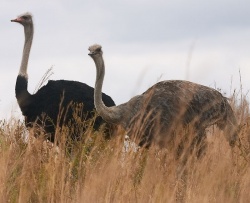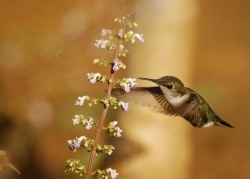- Aves (all birds)
Description
All birds are placed in the zoological class Aves. They are vertebrate, warm-blooded animals with wings, two feet and they lay eggs. They are characterised by some unique features:
- Feathers
- Laying of hard-shelled eggs
- Beak without teeth
- High metabolic rate
- Strong but lightweight skeleton
- Heart with four chambers
- Unique respiratory and digestive systems
The accepted number of species varies in the different sources, but there are about 10'000 species worldwide, found on all continents.
The largest bird ever described had a wing span of about 5.2 meters and lived 5-10 million years ago[2]. The smallest probably is the Bee Hummingbird.
Taxonomy
A number of traits are shared by both fossil dinosaurs and modern birds, such as the possession of a synsacrum and an open acetabulum have led to birds being classified within the Dinosauria. Birds are considered theropod dinosaurs, particularly maniraptorans, a group of theropods that includes famous fossil dinosaurs such as Velociraptor and Oviraptor.
Below is a list of all the orders in the class Aves that are recognized by Opus, which at this level of taxonomy follows the Clements Checklist of Birds of the World[1]. If you are looking for an order that you cannot find in this list, there may be a link to it at the end of this page; in the linked page you should find the families associated with that order as well as a link to the order under which those families are currently listed in Opus. Just typing in the name in the search field at the left probably will also find information about which orders currently hold the species associated with the order you are looking for
| |||
|---|---|---|---|
| Struthioniformes | Ostriches | ||
| Casuariiformes | Cassowaries and Emu | ||
| Apterygiformes | Kiwis | ||
| Rheiformes | Rheas | ||
| Tinamiformes | Tinamous | ||
| Anseriformes | Ducks, geese and allies | ||
| Galliformes | Fowl and allies | ||
| Columbiformes | Pigeons and allies | ||
| Mesitornithiformes | Mesites | ||
| Pterocliformes | Sandgrouse | ||
| Otidiformes | Bustards | ||
| Musophagiformes | Turacos | ||
| Cuculiformes | Cuckoos and allies | ||
| Caprimulgiformes | Nightjars and Allies | ||
| Nyctibiiformes | Potoos | ||
| Steatornithiformes | Oilbirds | ||
| Podargiformes | Frogmouths | ||
| Aegotheliformes | Owlet-nightjars | ||
| Apodiformes | Swifts, Treeswifts, and Hummingbirds | ||
| Gruiformes | Cranes, rails and allies | ||
| Charadriiformes | Shorebirds, gulls and allies | ||
| Phoenicopteriformes | Flamingos | ||
| Podicipediformes | Grebes | ||
| Opisthocomiformes | Hoatzin | ||
| Eurypygiformes | Kagu and Sunbittern | ||
| Phaethontiformes | Tropicbirds | ||
| Gaviiformes | Loons / divers | ||
| Sphenisciformes | Penguins | ||
| Procellariiformes | Petrels, shearwaters and allies | ||
| Ciconiiformes | Storks | ||
| Suliformes | Boobys, Frigatebirds and Coromorants | ||
| Pelecaniformes | Pelicans, Herons and Ibises | ||
| Cathartiformes | New World Vultures | ||
| Accipitriformes | Buzzards, Eagles, Kites, Hawks, Vultures | ||
| Strigiformes | Owls | ||
| Coliiformes | Mousebirds | ||
| Leptosomiformes | Cuckoo-Roller | ||
| Trogoniformes | Trogons and allies | ||
| Bucerotiformes | Hornbills, hoopoe and woodhoopoes | ||
| Coraciiformes | Kingfishers, rollers and allies | ||
| Galbuliformes | Jacamars and allies | ||
| Piciformes | Woodpeckers and allies | ||
| Cariamiformes | Seriemas | ||
| Falconiformes | Falcons and Caracaras | ||
| Psittaciformes | Parrots and allies | ||
| Passeriformes | Passerines / perching birds (5,000+ species) | ||
References
- Clements, J. F., T. S. Schulenberg, M. J. Iliff, D. Roberson, T. A. Fredericks, B. L. Sullivan, and C. L. Wood. 2018. The eBird/Clements checklist of birds of the world: v2018. Downloaded from http://www.birds.cornell.edu/clementschecklist/download/
- Birdforum discussion about the so far largest bird described for planet earth
Subcategories
This category has the following 45 subcategories, out of 45 total.





